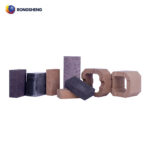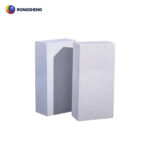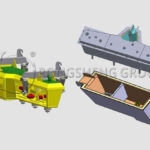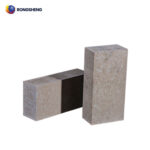Analysis on the Damage of Refractory Brick Lining for Lime Shaft Kiln
A lime shaft kiln preheating zone and calcining zone formed serious nodules. The maximum thickness of the nodules can reach 800mm, and the inner lining is seriously damaged. In particular, the surrounding working layer of the preheating zone about 1.5m away from the top of the kiln was damaged, with a distance of 2m. The damage on the east side is lighter than that on the west side. The damage of preheating refractory bricks is mainly caused by thermal stress and chemical erosion. The damage of the lining is shown in Figure 1. The lining bricks in the lower part of the calcining belt and the cooling belt are slightly damaged.
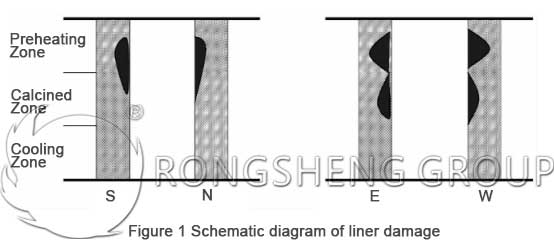
Refractory Bricks for Double-Chamber Lime Shaft Kiln
The preheating zone and cooling zone of the double-chamber lime vertical treasure are mostly built with clay bricks, the calcining zone is built with magnesia chrome bricks or magnesia bricks, and part of the preheating zone and cooling zone is built with magnesia refractory bricks. A small amount of magnesia ramming mass material is used for masonry in special parts of the magnesia kiln lining, and its quality is equivalent to that of magnesia bricks. The heat insulation layer of the kiln is made of light clay bricks.
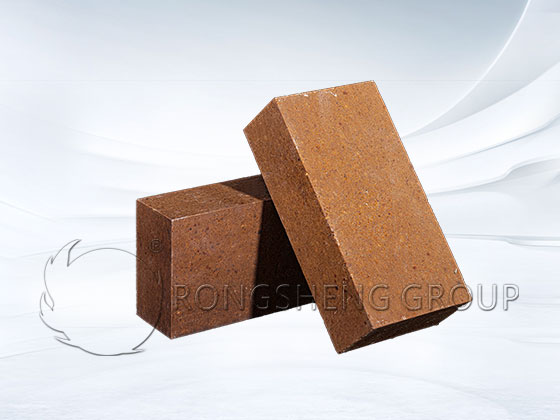

In the case of high-quality refractory bricks, the life of the kiln lining of the lime kiln can reach 4-6 years. Under normal circumstances, it can reach 12 years before all kiln linings need to be replaced. The properties of refractory bricks for lining are shown in Table 1.
Table 1 Refractory bricks for double-chamber lime shaft kiln
| Items | Magnesia Bricks at Calcined Zone |
Ordinary Magnesia Bricks | Dense Fireclay Bricks | Lightweight Fireclay Bricks | |
| Chemical Components / % | MgO | 76~96 | 73~86 | – | – |
| Cr2O3 | 0~11 | 0~7 | – | – | |
| Al2O3 | – | – | 36~40 | 39 | |
| SiO2 | – | – | – | 56 | |
| Crushing Strength / MPa | 39 | 29~78 | 44 | 4.4 | |
| Bulk Density / g/cm3 | 2.85~3.2 | 2.9~3.1 | 2.2 | 0.9 | |
| Porosity / % | -20 | 15~20 | 16 | 64 | |
| Load Softening Start Temperature / ℃ | 1600 | Ta = 1600 Tb = 1650 |
Ta =1400 | – | |
| Operating Temperature | – | – | – | 1300 | |
Analysis of Damage Mechanism of Lime Shaft Kiln Lining
(1) The upward movement of the calcining belt causes the preheating zone to withstand high-temperature reactions.
One of the reasons is the imbalance of atmosphere. The second is excessive wind. Third, the ash output is small or the ash output interval is too long.
(2) The alkaline oxide of limestone is easy to chemically react with silicate refractory bricks at high temperatures.
Among them, CaO and Al2O3 produce 3CaO·Al2O3 at a melting temperature of 1545°C. Fe2O3 is included in the impurities introduced by the raw materials. When the melting point is 1415″C, 4CaO·Fe2O3·Al2O3 is formed. In the high temperature zone of the kiln, when the high temperature exceeds 1400°C locally, the lining bricks in this part will melt with low melting material and melt damage. Within the normal calcination temperature range, the impurities (silt containing SiO2, Na2O, K2O) and limestone brought in by the stone react with the aluminum silicate refractory bricks to produce quaternary and pentavalent minerals with 3CaO·AI2O3 as the matrix. Its melting point is lower.
At the same time, under high temperature conditions, the decomposed CaO at the wall of the kiln invades along the pores of the lining brick working face and chemically reacts with the lithofacies in the brick. The above-mentioned low-melting-point salts will also be generated, which will soften the working surface of the brick, and this erosion will continue to penetrate and diffuse into the brick. At the same time, the thermal stress of the lining brick and the expansion of the recrystallization volume inside the brick under high temperature will cause cracks on the working surface of the brick, resulting in a loose structure, which will bury hidden dangers for future damage.
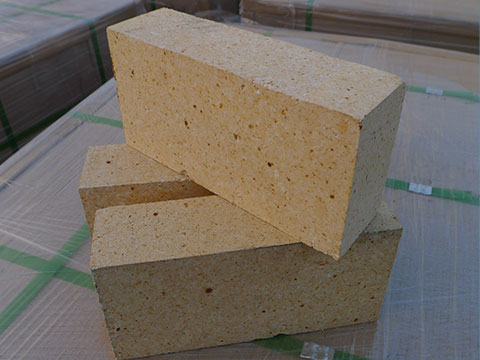
(3) The influence of kiln wall effect.
Shaft kiln production inevitably has “kiln wall effect”. Sometimes due to the poor air permeability of the kiln, the increased ventilation resistance can form a larger “kiln wall effect”, which makes the kiln easy to have a high temperature exceeding 1400°C. As mentioned above, the reason why the east side of the preheating zone is less damaged than the west side is that the east side has poor air permeability after the kiln wall effect caused by fabric segregation, while the west side has good air permeability, resulting in high temperature segregation. When the calcining belt moves up, a high temperature of 1400~1500°C will be formed around the kiln in the combustion zone, and the clay bricks or high alumina bricks used will be quickly damaged.
(4) The influence of kiln wall nodules.
A thin layer of knots on the wall of the kiln can protect the lining of the kiln to a certain extent. Avoid refractory bricks leaking naked in the flame. If the tumor is thick, it will affect the air volume distribution in the kiln and the smooth cutting of the material, which will have a counterproductive effect. The limestone used in our factory often exceeds the standard of impurity content. Especially in the rainy season, the silt adheres to the limestone and is burned together in the kiln. It is easy to see the nodulation from the observation hole. Impurities react with CaO at high temperature to produce 4CaO·Fe2O3·Al2O3, CaO·Al2O3 and slag sticks on the kiln wall to form kiln wall tumors. Under high temperature, the nodules become bigger and stronger, and stronger. It is also possible to increase the amount of liquid phase in the brick body to reduce the strength of the brick. Pulled by the impact of the material, once the nodules are peeled off, the refractory bricks will be loosened or fall off with the nodules. In the later stage of the use of a set of kiln lining bricks, the adhesive tape of the lining bricks often falls off. It can be seen that in the later use of the kiln lining, nodulation is an important factor affecting the age of the furnace.
(5) The impact of kiln shutdown.
The plant’s 6x155m3 white ash shaft kiln uses blast furnace gas as fuel. Only when the blast furnace goes forward, it is possible to obtain a stable gas supply. In recent years, the multi-pipe network gas is not balanced in areas where the company’s technological transformation projects use more gas, causing the shaft kiln to be ordered to shut down frequently and then the temperature rises again. This means that refractory bricks have to undergo a process of alternating hot and cold. Refractory bricks are easy to crack and peel off layer by layer after experiencing rapid cold and rapid heat. After the kiln was shut down to resume production, there was a 0.5cm thick refractory material on the nodules found on the finished chain plates. This is caused by the temperature stress after frequent temporary shutdown of the kiln.
(6) The influence of kiln lining brick masonry quality.
The quality of masonry directly affects the operating cycle of the kiln. If the masonry is not good enough, bricks will fall off. High temperature will appear in the kiln and some parts, and the kiln skin will see red in severe cases. There must be a certain temperature gap between the brick rings, which is the space left for the thermal expansion of the refractory bricks. If the brick gap is too small, the refractory bricks will be crushed by being squeezed and crushed by heat expansion, which will also affect the service life. If the refractory mud has large moisture or the brick joint refractory mud is not full and thick, large shrinkage joints or cracks will occur due to the violent evaporation of moisture during the ignition and drying process, which will bury hidden dangers for the falling of the lining brick.
Rongsheng Refractory Manufacturer
Rongsheng is an experienced manufacturer of refractory materials. Rongsheng can provide high-quality refractory lining materials for the construction and repair of refractory linings of various furnaces. Rongsheng’s refractory bricks and refractory castables have advanced production lines and experienced refractory experts. Therefore, we can also provide customized refractory products for kiln equipment. Rongsheng’s refractory products have been sold to more than 60 countries around the world, for example, Russia, South Africa, Kazakhstan, Philippines, Chile, Malaysia, Uzbekistan, Indonesia, Vietnam, Kuwait, Turkey, Zambia, Peru, Mexico, Qatar, etc. If you need to buy refractory lining materials for furnaces, please contact us. We will provide you with services according to your specific needs. We look forward to your being able to visit our website and establish cooperation with us.

